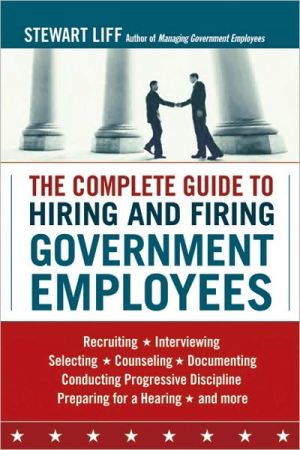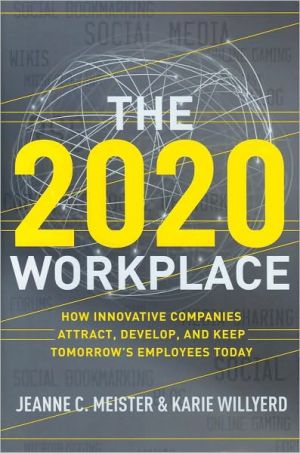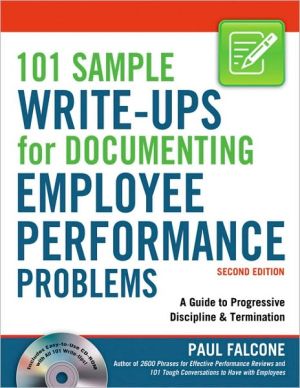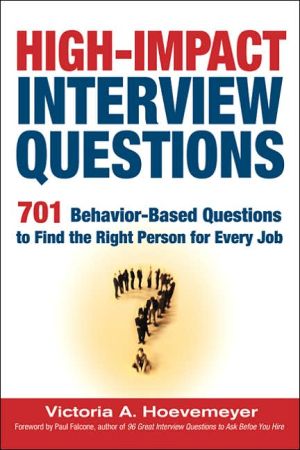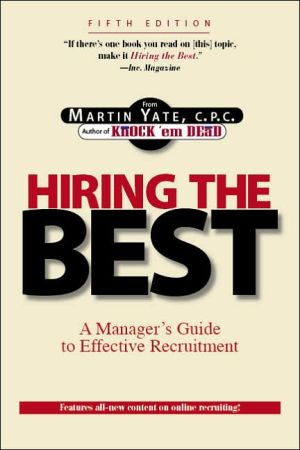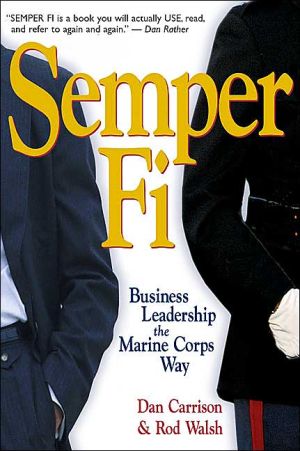The Complete Guide to Hiring and Firing Government Employees
Government bureaucracy can often make hiring great employees a cumbersome, slow-moving process. But with the right advice from a seasoned mentor who’s been there, seen it all, and managed to assemble high-performing, productive groups of people, you’ll be able to surround yourself with great work teams on a consistent basis throughout your career.\ By the same token, during the course of your career as a government manager, chances are you will find that some of your employees are simply not...
Search in google:
Government bureaucracy can often make hiring great employees a cumbersome, slow-moving process. But with the right advice from a seasoned mentor who’s been there, seen it all, and managed to assemble high-performing, productive groups of people, you’ll be able to surround yourself with great work teams on a consistent basis throughout your career.By the same token, during the course of your career as a government manager, chances are you will find that some of your employees are simply not working out. They may be hold-overs from the past who have never been good employees and have never been dealt with; they may be good employees whose performance has suffered due to personal problems or other reasons; or they may be recent hires who turned out to be poor selections despite your best efforts. Like it or not, it’s your responsibility to document and deal with those who don’t make the cut, as well as bring on board the best talent available in the first place.Based on author Stewart Liff’s extensive experience as a government human resources management expert, as well as his many years as a government line manager and senior executive, The Complete Guide to Hiring and Firing Government Employees shows you how to cut through the red tape and:• take an anticipatory approach to recruiting • decide who to target and where and how to advertise for open positions • screen and interview candidates • counsel a poor-performing employee • use progressive discipline • document a case • write a charge • develop internal political support • prepare for and win a third party hearing • and continuously maintain an entire department of exceptional performers.Filled with smart, no-nonsense strategies you can adapt in any hiring and firing situation, this book is a powerful resource that will enable you to maintain an efficient, productive work team at all times.Praise for Managing Government Employees by Stewart Liff“[Liff’s] 32-year career, which includes service at both the management and executive levels in the Department of Defense, General Service Administration, Federal Energy Administration, and Veterans Health Administration, make Managing Government Employees an extraordinarily credible endeavor. …a ‘must-read’ for those contemplating entering management…. his comments and insights are useful to all managers, particularly first-line managers, everywhere.” — Graziadio Business Report“Stewart Liff provides many great tactics, case studies and stories that debunk common perceptions that government managers have of the government’s personnel system…. This book should be required reading for all supervisors in government.” — GovLeaders.org
Introduction\ THIS BOOK WAS WRITTEN to address two of the most important issues\ that government managers will ever have to face: how to hire and fire a government\ employee. Neither of these is easy, but in all probability, you will\ need to do both in order to succeed.\ Most likely, you will hire far more employees than you will fire—if not,\ something is definitely wrong. After all, if you spend most of your time correcting\ bad hiring decisions, what does that say about your hiring process?\ Moreover, you will find yourself devoting far too much of your precious\ time looking for ways to get rid of bad employees instead of performing your\ day-to-day job responsibilities.\ In the course of a long career, you may hire dozens if not hundreds of\ people, and make no mistake about it, the quality of the people you hire will\ go a long way toward determining how successful you are as a manager.\ Unfortunately, in my experience, government managers often spend an inordinate\ amount of time bringing in large groups of new hires without devoting\ enough time to strategizing how to bring in the best possible group of new\ employees. As a result, these managers find themselves hiring a mix of candidates,\ many of whom prove to be less than optimal selections. Eventually, the\ managers wind up scrambling to try and deal with the problems inherent in\ a weak workforce. These problems range from a wide variety of training\ challenges to employee relations issues to performance problems, many of\ which could have been avoided had managers taken more time to plan properly\ and had they possessed the skills needed to hire an excellent group of\ new employees in the first place.\ That is not to say that it is easy to hire top-notch government employ-\ ees. It most certainly is not. The government’s laws, rules, regulations, and\ procedures for hiring, regardless of whether it’s at the federal, state, or local\ levels, are for the most part complex, convoluted, time-consuming, and in\ many cases highly frustrating—to both government managers and the people\ trying to get jobs with the government. In addition, the requirements of\ factoring in veterans’ preference, the legitimate concerns about equal\ employment opportunities (EEO) for all, competition from the private sector\ (which can hire more quickly and doesn’t have the same procedures as\ the government), centralized pressure to hire quickly when recruitment\ authority is granted, unanticipated budget crunches, rigid pay systems, hiring\ freezes, and others all make the hiring process challenging for government\ managers.\ According to the United States Merit Systems Protection Board (MSPB),\ which serves as an independent, bipartisan guardian of the merit systems\ under which federal employees work, “There are barriers to recruiting a high\ quality workforce. . . . First-line supervisors and other managers still indicate\ that they have problems recruiting highly qualified applicants. These problems\ may be due to insufficient recruitment strategies or incentives, the\ slowness of the hiring process, or the use of inadequate measuring instruments,\ and agencies should examine them further.”1\ That being said, government managers can take many steps to enable\ themselves to hire excellent employees, and that is part of the basis for this\ book. Having been a government employee for more than 32 years, and a\ government manager and leader for 28 years, I know firsthand what it is like\ to try and hire employees within the constraints that exist.Moreover, during\ nearly my entire career, I have hired people while working in high-cost areas\ such as New York City, Los Angeles, and Washington D.C., which only made\ the challenge even greater.\ The first half of this book is devoted to showing readers how to hire\ excellent government employees in a logical, integrated, and comprehensive\ fashion. It is intended to be a road map for hiring quality people within a\ government personnel system, regardless of the level of government. It is\ based on both my experiences as a government human resources management\ (HRM) expert and my many years as a government line manager and\ senior executive.\ This book is not meant to provide a “one-design-fits-all” approach to\ recruitment. Rather, it offers a series of philosophies, strategies, and recruitment\ tactics based on a deep understanding of the government’s HRM systems\ and many years of working in the real world of government staffing\ and line management that can then be customized to a specific, local situation.\ The book is also designed to help you look at your entire process, ranging\ from the time before vacancies even exist to the moment you begin your\ recruitment process through rating and ranking candidates and up to the\ final selection process and its aftermath. I am confident that if you adopt this\ holistic approach, it will greatly aid you in building a first-class government\ workforce—and preclude you from having to deal with too many poor-quality\ employees down the road.\ While building your workforce, it is quite likely that you are going to\ find that one or more of your employees are simply not working out. They\ may be holdovers from the past who have never been good employees and\ have not been dealt with, they may be good employees whose performance\ has suffered due to personal problems or other reasons, or they may be\ recent hires who turned out to be poor selections despite your best efforts.\ Regardless of the reason, most organizations, including high-performing\ ones, have some poor performers. The difference is that the best organizations\ deal with these employees, and the more marginal ones do not. This seems\ to be especially true for government, given its myriad rules and culture,\ wherein far too many problem employees are allowed to coast through their\ jobs.\ From my perspective, this happens because many, if not most, government\ managers have bought into the perception that you can’t fire a bad\ employee. They believe that it is too difficult, too time-consuming, and too\ much work so they often give up before they even get started. Personal experience,\ or the lessons they have learned from others, has taught managers\ that there is no point in trying to remove a bad apple because in the end they\ will not prevail. So why go through all of the pain and suffering that the government’s\ personnel system will impose on them?\ The problem with this type of thinking is that it perpetuates the widespread\ belief that you can’t fire a bad government employee. Once the public\ believes this myth, it undermines their faith in government. Once your\ employees believe this, it ruins their morale and makes them conclude that\ they are working for a less-than-stellar organization that is not interested in\ high performance. When your problem employees see that management is\ not prepared to deal with them, they will be emboldened to slack off even\ more and will try to influence marginal employees to take the same\ approach. In short, you will be encouraging a cancer to metastasize in your\ organization at a rapid rate.\ This does not have to happen in government, nor should it. However, it\ has been happening for decades because government leaders have done a relatively\ poor job of building accountability into its personnel systems; leaders\ have not taught their subordinate supervisors why it is so important to\ deal with problem employees up front; and supervisors do not really know\ how to go about actually dealing with a poor employee.\ According to the MSPB, “In many Federal organizations, there is a culture\ that sanctions not dealing effectively with problem employees. This\ must be changed for the Government to effectively hold employees accountable\ for their performance.”2\ Make no mistake about it, changing the culture is not an easy thing to\ do. The system is definitely complex and requires a high degree of technical\ knowledge, which most supervisors do not possess.Moreover, going through\ the process is not a pleasant experience because you will likely experience\ pushback from the affected employee(s), which may very well entail one or\ more complaints being filed against you. You may also get second-guessed or\ overturned by upper management at some point in the process, which will\ make your experience even more frustrating.\ Herein lies the problem: How do we change the way that government\ operates so that its management officials recognize that it is in their best\ interest to deal with their problem employees? According to an MSPB report,\ . . . despite the claims of some supervisors to the contrary, we\ believe that the current system can provide the means to\ deal with problem employees. This does not imply that\ changes to the current system should not be considered; it\ only implies that managers should not wait for systemic\ adjustments before they take appropriate action in this area.\ The current system does not, of course, make the process of\ dealing with problem employees a particularly pleasant experience.\ Nor does the system work well unless management\ creates an organizational climate that makes it clear to all\ employees that poor performance or misconduct will not be\ tolerated.3\ I fully agree with that conclusion, which, by the way, was reached about\ 10 years ago. Since the time that MSPB report was issued, there have been no\ significant changes to the system. The key continues to be to change the\ mind-set of government managers by showing them the way and providing\ them with the skills necessary to deal with poor employees, which includes\ firing employees when necessary.\ That is the purpose of the second part of this book: to teach readers how\ to successfully terminate poor employees within the system that currently\ exists.When appropriate, it should be and can be done.\ Before I continue, let me be clear about one thing: You should fire a government\ employee only as a last resort and only when it is the right thing to\ do. Never fire someone because it is expedient or because you are trying to\ show that you are a “tough guy.” Only take this step when it is appropriate\ and will promote the efficiency of the government. Remember, your organization\ has already invested an enormous amount of time, energy, and\ money in the employee, so you should fire the person only when there is no\ other reasonable alternative.\ Please note that I do not consider a reasonable alternative to be moving\ a problem employee from one team to another without addressing the root\ cause. Otherwise you are merely perpetuating the problem, creating\ headaches for the employee’s new supervisor, and sending a message to the\ rest of the workforce that you are not serious about dealing with difficult\ employees.\ Also, I do not consider giving a well-known problem employee a “slap\ on the wrist” because that is not going to change his behavior either. As you\ will learn later on in this book, in order to successfully deal with a true problem\ employee, as opposed to a good employee whose conduct or performance\ problem is merely an aberration, you need to let the employee know\ that if he doesn’t change his performance or behavior, you are prepared to\ remove him. That is the only way to let the employee know you are serious.\ After all, when you are dealing with someone who is truly a problem (i.e.,\ someone who is in the bottom 10 percent of your workforce), the only successful\ outcomes are to either change the person or change the person. The\ one outcome that is not acceptable is maintaining the status quo, wherein\ the employee continues to behave and act in an unacceptable manner. That\ must change; otherwise, the employee will surely pollute your workplace and\ other employees will conclude that management is sanctioning the employee’s\ actions and that “what’s good for the goose is good for the gander.”\ If there are no reasonable alternatives to firing the employee, and progressive\ discipline has not worked (more about that topic in Section 2: How\ to Fire a Government Employee), then by all means go forward and take\ action to remove the employee. This book will show you how to fire an\ employee in a fair, logical, and defensible manner. It will provide you with\ tips on how to go about it, including how to conduct an investigation, how\ to document your actions, how to write charges, how to put together an evidence\ file, how and when to settle a case, and, if not settlement, how to prevail\ before a third party. It will also demystify the process for you, so you will\ know what you are getting into, what the potential pitfalls are (and how to\ avoid them), and what to expect along the way.
Introduction xiSection I How to Hire a Government Employee 11 The Government's Hiring Process 3History 4Outlook 13Look at Your Own Processes 162 Developing Your Strategy 19Anticipatory Recruitment 21Traditional Approach 22Anticipatory Recruitment Approach 23Targeting Your Pool 24The Vacancy Announcement 25Deciding Who to Target 28Expect the Unexpected 33Where and How to Advertise 34Getting Out into the Market 35Making Your Organization More Desirable 37Don't Forget the People Who Already Work for You 403 Screening and Interviewing the Candidates 45Screening 45Rating 45Substitution of Education for Specialized Experience 46Ranking 5Veterans' Preference 535-Point Preference (TP) 5310-Point Disability Preference 54Interviewing 55Preparation 56The Interview Itself 584 Post-Interview Review/Making Your Decision 65Following Up with Previous Employers 67The Selection Itself 69The Rule of Three 70Rule of Three Considerations 71Veterans' Preference 72Objecting to Veterans 74Category-Based Ratings 75Who to Select 77Once the Selection Is Made 79Orientation 79Section 2 How to Fire a Government Employee 815 Handling Poor Employees 83Why Does the Government Not Deal with Poor Performers as Frequently as It Should? 85History of Employee Protections in the Civil Service 85Working the System 91What Can Be Done to Change the Way That the Government Holds Its Employees Accountable? 93Your Organization's Mind-Set 94The Skills and Abilities of Your Management Team 96Your Advisors 98Your Overall Strategy for Dealing with Poor Employees 100Identify ProblemEmployees 100Bring the Problem to a Head 102Take as Strong an Action as You Can 103Weeding Out Problem Employees during Probation 1056 Firing for Misconduct 109The Investigation 110Deciding What to Do 113Burden of Proof 114Writing and Issuing the Proposed Removal 125Sample Proposed Removal Letter 130Considering the Employee's Response 133The Decision Letter 137Sample Decision Letter 1377 Firing for Poor Performance 141Overview 141Performance Appraisal System 143Performance Standards 145Communication and Feedback 150Sample Counseling Letter 152Going Forward 153Dealing with a Poor Performer 155Sample Performance Improvement Letter 159The Opportunity Period 161Sample Memo Documenting PIP Counseling 163Employee Allegations and Requests 164When the Opportunity Period Ends 167Sample Proposed Removal Letter 169The Decision to Fire 171Sample Decision Letter 1728 The Hearing 175Where Employees Can Appeal Their Removals 176Merit Systems Protection Board 177Arbitration 178Framing the Issue 179Discovery 180The Hearing 181Likelihood of Success 182Cost 184Your Representatives 185The Evidence File 187Preparing for the Hearing 188The Hearing Itself 194Settling the Case 195Opening Statement 197Presenting Your Case 197Addressing the Appellant's Case 199Closing Arguments 200Notes 203Index 219
\ From the Publisher"Unlike other government reference books, the author shares his government experience and expertise with human resources and management and sheds light on its many nuances. He also provides a roadmap and reference tool to the potential pitfalls that experienced and inexperienced federal managers face daily....Not another door stop or dust gatherer. 4 out 4 of stars if used earnestly by federal mangers and supervisors." --Oh My Gov!\ "Liff's new book tosses aside the typical esoteric discourse on civil service reform and hunkers down into the weeds of current law to help managers figure out how to hire the best workers and get rid of the worst now -- not in some utopian, imaginary world of the future." --Government Executive\ \ \
